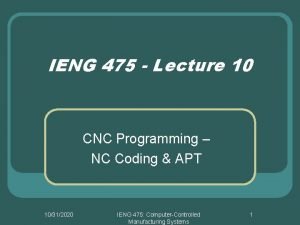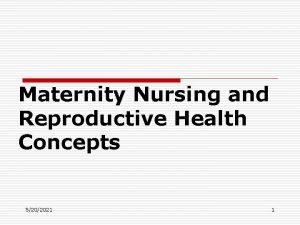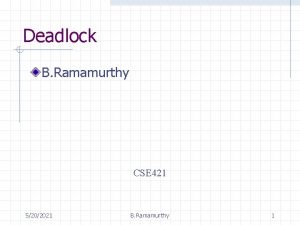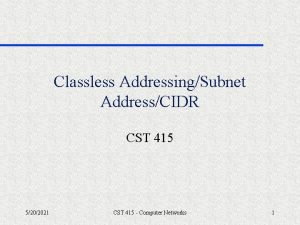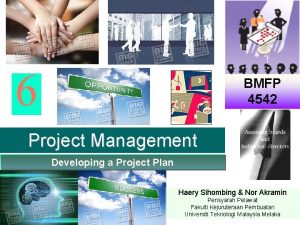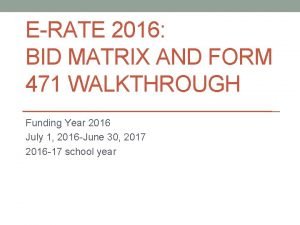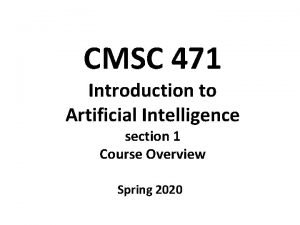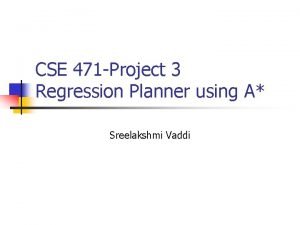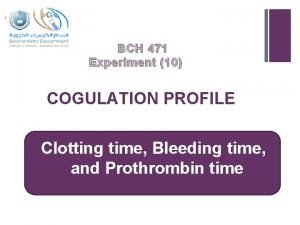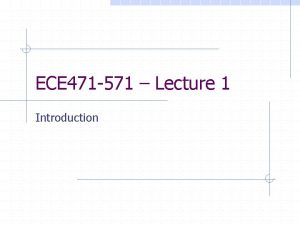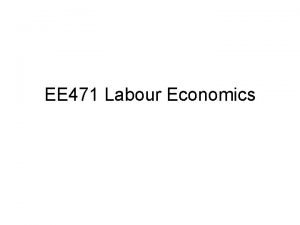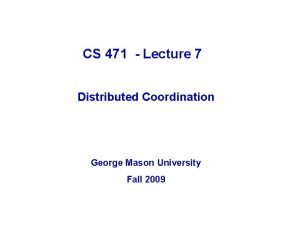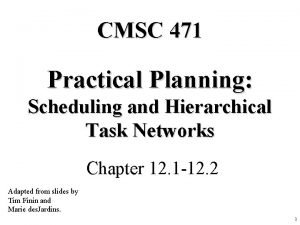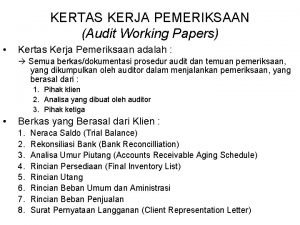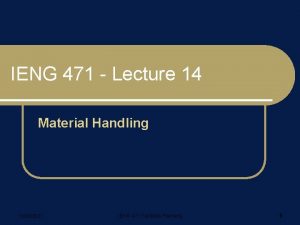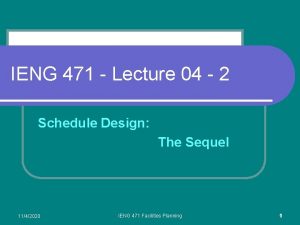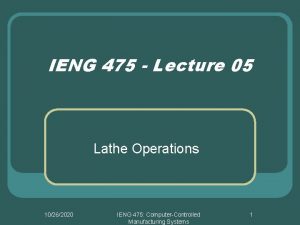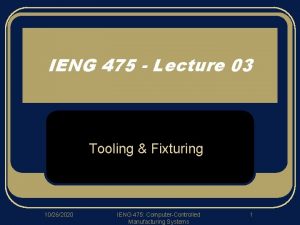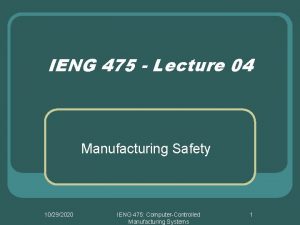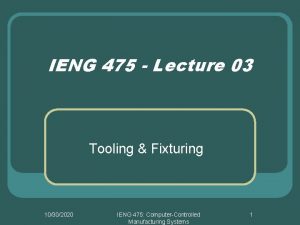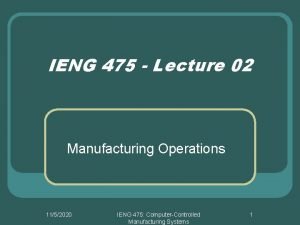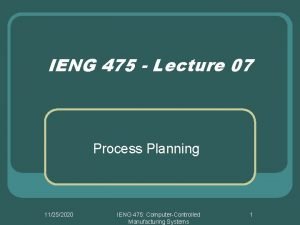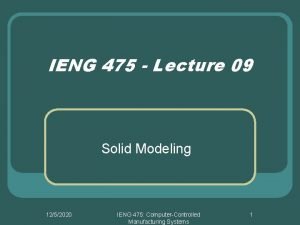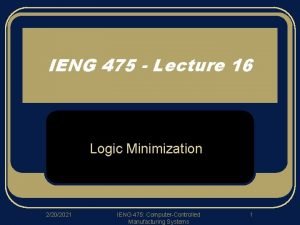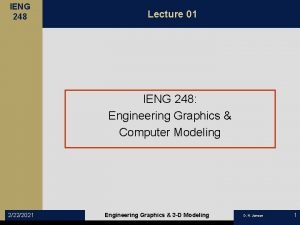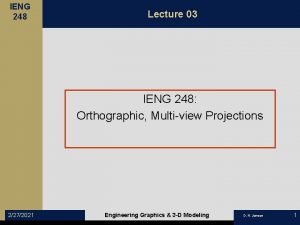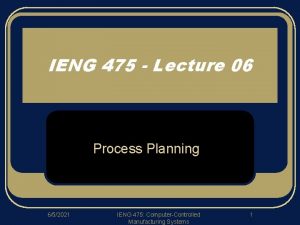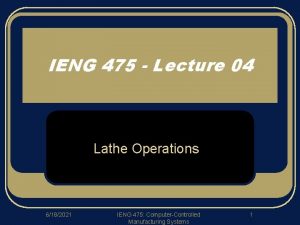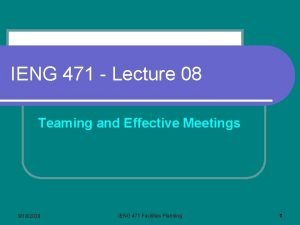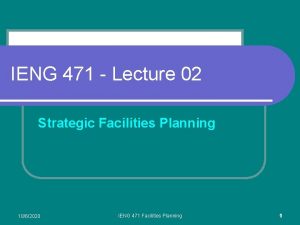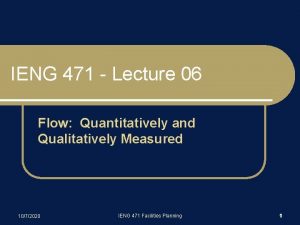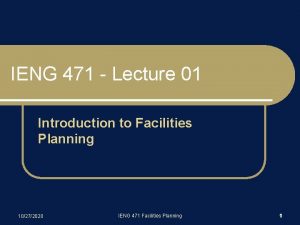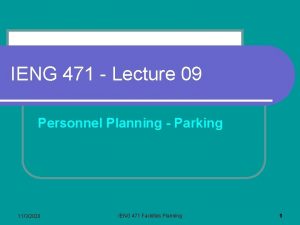IENG 471 Lecture 04 Schedule Design 5202021 IENG






















- Slides: 22

IENG 471 - Lecture 04 Schedule Design 5/20/2021 IENG 471 Facilities Planning 1

Assignments l Current Assignment: l HW: l l (HW 2) Product BOM Product Operation Process Chart Product Precedence Diagram PERT Chart w/ timings l Next Assignment: l HW: (HW 3) Difficult HW Teams of 4 or 5 (NO LESS!) l required input for each of the workstations l equipment necessary for each machine l steady state cycle time for each machine l ideal machine assignment for each machine l compute the idle time l unit cost at each workstation l total cost per good unit l square footage for each workstation and the total space required 5/20/2021 IENG 471 Facilities Planning 2

Schedule Design Overview l Schedule Design is undertaken to decide for a facility design: l How much should the facility be designed to produce l When should the facility be able to produce the product 5/20/2021 IENG 471 Facilities Planning 3

Impacts of the Schedule Design: l The Schedule Design of the facility will impact: l Types of machines required l Processing equipment l Storage equipment l Material handling equipment l Number of machines required l Number of employees required l Space requirements l For all of the above, plus support functions (services, utilities, …) 5/20/2021 IENG 471 Facilities Planning 4

Information Req’d: Marketing l What products are to be produced l What volume of each product is expected to be produced (and when) l How probable are the production requirements l Seasonality and life cycle considerations l Where are the products to be delivered l Who will acquire the products l What are the product development plans 5/20/2021 IENG 471 Facilities Planning 5

Production Volume l Types of Manufacturing Systems: l Job Shop l Batch/Cellular l Mass Production l Approximate Annual Volume: Type of Production Job Shop Prototype No. Produced 1 - 10 Kalpakjian Typical Products Anything Piece/Small Batch 10 - 5, 000 Batch/High Volume 5, 000 - 100, 000 Trucks, Ag. Equip. , Engines Over 100, 000 Cars, Appliances, Fasteners Mass Production 5/20/2021 IENG 471 Facilities Planning Aircraft, Machinery, Dies 6

Characteristics Type of Production System Job Shop Batch Prod. Kalpakjian Mass Prod. (Arrows point in the direction of increase) General Equipment Special Production Rate Production Quantity Process Plant Layout Flow Line Labor Skill Part Variety 5/20/2021 IENG 471 Facilities Planning 7

Example Job Shop Layout Drill Grind H. Mill V. Mill Drill CMM Receiving Lathe L. Paint Oven Lathe 5/20/2021 Lathe Shipping P. Paint IENG 471 Facilities Planning 8

Example Mass Production Layout V. Mill H. Mill Drill Grind Lathe CMM Receiving L. Paint Oven Shipping 5/20/2021 IENG 471 Facilities Planning 9

Example Batch/Cell Production Layout V. Mill Drill Grind H. Mill Drill Lathe CMM L. Paint Receiving Oven Shipping 5/20/2021 IENG 471 Facilities Planning 10

Volume, Variety & Automation 100, 000 Rembold, et. al. Transfer Line High Batch Flow Line Production Quantity 10, 000 Increasing Productivity 1, 000 Medium Flexible Mfg Sys 100 Low Mfg Cell NC Machine 1 1 Low 5/20/2021 Increasing Flexibility 10 100 Medium Part Variety IENG 471 Facilities Planning 1, 000 High 11

Which Type to Use? : Pareto Chart 5/20/2021 40 40% 20 20% 0 0% IENG 471 Facilities Planning Product Type 12 Cumulative % 60% Prod H 60 Prod G 80% Prod F 80 Prod E 100% Prod D 100 Prod C 120% Prod B 120 Prod A l Histogram categories are sorted by the magnitude of the bar l A line graph is overlaid, and depicts the cumulative proportion of products l Quickly identifies where to focus efforts Pareto Chart for Product Volume Est. Volume Req’d l 80% of any problem is the result of 20% of the potential causes*

Estimating Production Volume with Scrap l The production facility must operate in the “real world” l In the real world, things go wrong – defects! l To size the facility, the plant capacity must include extra volume for scrap: l At a single workstation (k) the formula is: where: l Ik is the input amount required for the process to achieve goals l Ok is the output amount required of the process, and l Pk is the percentage of scrap generated by the process per unit 5/20/2021 IENG 471 Facilities Planning 13

Estimating Production Volume with Scrap l Most processes are a sequence of operations l We need to know the sequence and individual scrap rates of each of the operations… l Good thing we got those Operation Process Charts! l Assuming that each unit must go through each operation in a chain of operations, the plant capacity must include extra scrap volume: l At end of a single chain of (n) individual operations, the formula for total input volume required is: where: l On is the output amount required at the end of the operation chain, and l Pk is the percentage of scrap per unit generated by the kth operation, starting with operation 1 and continuing through operation n 5/20/2021 IENG 471 Facilities Planning 14

Example 1: Express Input 1 as a function of the Quota I 1 1 P 1=2% 5/20/2021 O 1=I 2 P 2=5% 2 O 2=I 3 3 P 3=1% IENG 471 Facilities Planning O 3=I 4 4 O 4=Q P 4=0. 5% 15

Example 2: Express Input 1 as a function of the Quota I 1 1 P 1=2% O 1=I 2 O 2+OR=I 3 2 IR P 2=5% OR 3 P 3=1% O 3=I 4 4 O 4=Q P 4=0. 5% R PR=1% 5/20/2021 IENG 471 Facilities Planning 16

Example 3: Express Input 1 as a function of the Quota I 1 1 O 1+OR=I 2 IR OR P 2=5% P 1=2% 2 O 2=I 3 3 P 3=1% O 3=I 4 4 O 4=Q P 4=0. 5% R PR=1% 5/20/2021 IENG 471 Facilities Planning 17

Example 4: Find Input 1 and the system Total Scrap Cost I 1 1 P 1=3% S 1=$5 5/20/2021 O 1=I 2 P 2=5% S 2=$10 2 O 2=I 3 3 Q=1000 P 3=7% S 3=$15 IENG 471 Facilities Planning 18

Example 5: Find Input 1 and the system Total Scrap Cost (Note: Proportion scrap reversed from Example 4) I 1 P 1=7% S 1=$5 5/20/2021 1 O 1=I 2 P 2=5% S 2=$10 2 O 2=I 3 3 Q=1000 P 3=3% S 3=$15 IENG 471 Facilities Planning 19

Critical Thinking With Models: How do the first three models inform us? I 1 1 P 1=2% O 1=I 2 O 2=I 3 2 P 2=5% I 1 1 P 1=2% O 1=I 2 3 2 IR P 2=5% OR 4 3 O 3=I 4 4 I = 1. 036 Q PR=1% 1 O 1+OR=I 2 IR OR P 2=5% P 1=2% 2 O 4=Q P 4=0. 5% P 3=1% R I 1 O 4=Q I = 1. 090 Q P 4=0. 5% P 3=1% O 2+OR=I 3 O 3=I 4 O 2=I 3 3 P 3=1% R O 3=I 4 4 O 4=Q P 4=0. 5% I = 1. 069 Q PR=1% 5/20/2021 IENG 471 Facilities Planning 21

Critical Thinking With Models: How do the last two models inform us? I 1 1 P 1=3% S 1=$5 O 1=I 2 2 P 2=5% S 2=$10 O 2=I 3 3 P 3=7% S 3=$15 I = 1167 I 1 P 1=7% S 1=$5 1 O 1=I 2 P 2=5% S 2=$10 2 O 2=I 3 3 Tsc = $ 1870 Q=1000 P 3=3% S 3=$15 I = 1167 5/20/2021 Q=1000 IENG 471 Facilities Planning Tsc = $ 1415 22

Critical Thinking With Models l How do the first three models inform us? l Ex 1. 4 stations, no rework: l Ex 2. 4 stations, rework at Sta. 2 (5% scrap): l Ex 3. 4 stations, rework at Sta. 1 (2% scrap): I = 1. 090 Q I = 1. 036 Q I = 1. 069 Q l How do the last two models inform us? l Ex 4. 3 stations, scrap rate increases from Sta. 1 to Sta. 3: I = 1 167 Tsc = $ 1 870 l Ex 5. 3 stations, scrap rate decreases from Sta. 1 to Sta. 3: I = 1 167 Tsc = $ 1 415 l What are the facility design implications? 5/20/2021 IENG 471 Facilities Planning 23
 5 letter words with ieng
5 letter words with ieng 5202021
5202021 5202021
5202021 5202021
5202021 5202021
5202021 01:640:244 lecture notes - lecture 15: plat, idah, farad
01:640:244 lecture notes - lecture 15: plat, idah, farad Bmfp
Bmfp Erate frn
Erate frn Cmsc471
Cmsc471 Cse 471 asu
Cse 471 asu Cse 471
Cse 471 Importance of clotting time
Importance of clotting time Ece 471
Ece 471 Cse 471 asu
Cse 471 asu Ee 471
Ee 471 Cse 471
Cse 471 Cse 471
Cse 471 Cs 471 gmu
Cs 471 gmu Cmsc 471
Cmsc 471 Cmpt 471
Cmpt 471 Contoh kertas kerja pemeriksaan perusahaan
Contoh kertas kerja pemeriksaan perusahaan Eurocode 2 lap length table
Eurocode 2 lap length table Urban design lecture
Urban design lecture
